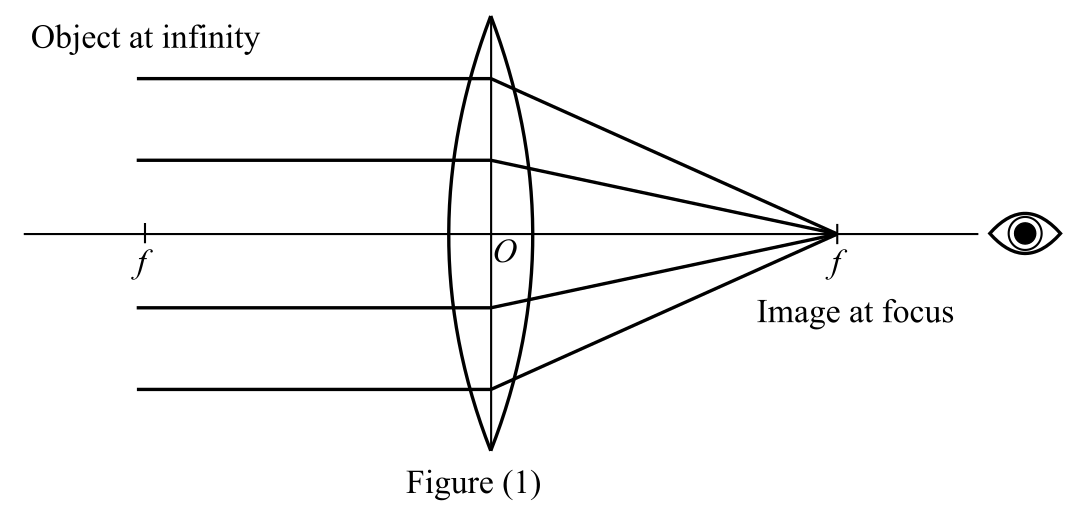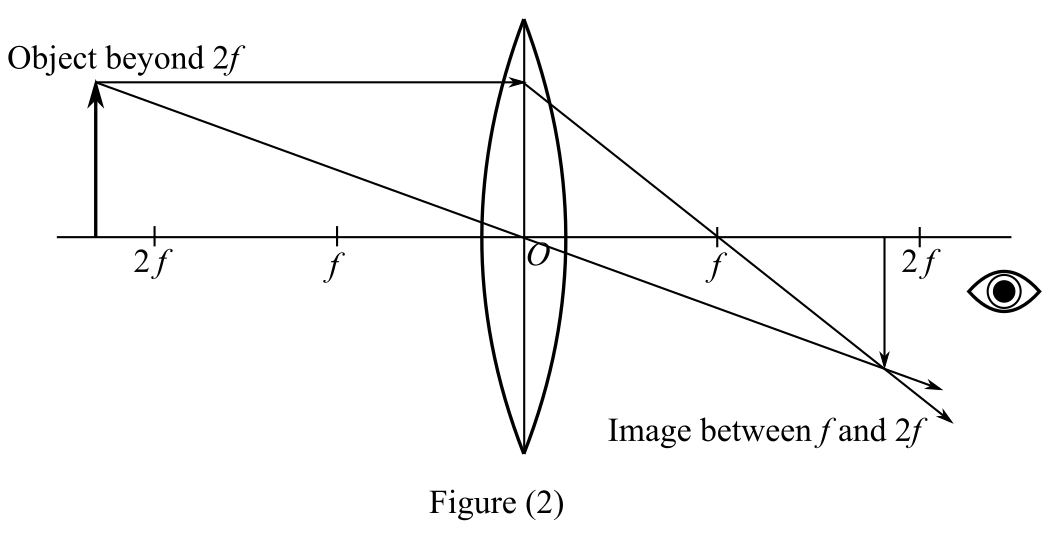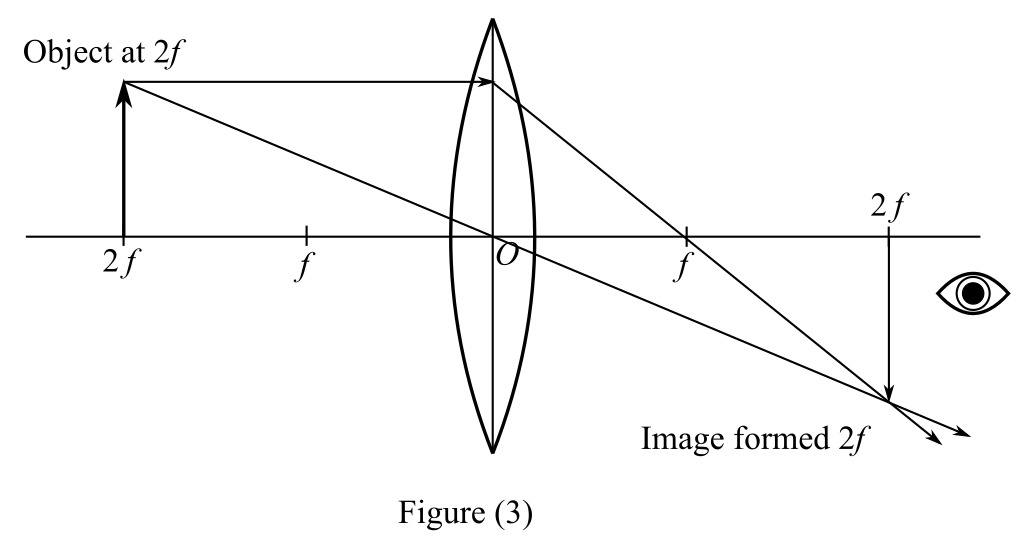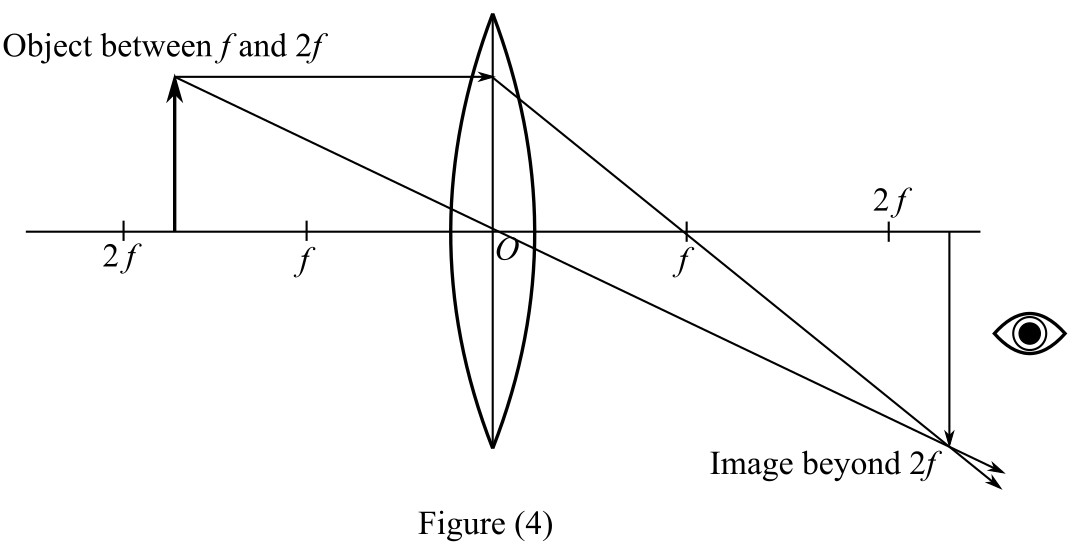
Concept explainers
Draw diagrams to indicate qualitatively the position, nature, and size of the image formed by a converging lens of focal length f for the following object distances: (a) infinity, (b) greater than 2f, (c) equal to 2f, (d) between 2f and f, (e) equal to f, (f) less than f.
(a)
The position, nature, and size of the image formed by a converging lens of focal length
Answer to Problem 15SP
Solution:
The image is formed at the focus and is inverted, real, and highly diminished.
Explanation of Solution
Introduction:
Employ the rules of ray diagram for a convex lens to determine the position, nature, and size of the image formed.
Explanation:
The resulting ray diagram for an object kept at infinity is drawn below:

From the ray diagram given above, it is clear that the image is formed at the focus and is inverted, real, and highly diminished.
Conclusion:
Therefore, when the object is kept at an infinite distance from the lens, the image is formed at the focus and is inverted, real, and highly diminished.
(b)
The position, nature, and size of the image formed by a converging lens of focal length
Answer to Problem 15SP
Solution:
The image is formed between
Explanation of Solution
Introduction:
Employ the rules of ray diagram for a convex lens to determine the position, nature, and size of the image formed.
Explanation:
The resulting ray diagram for an object kept at a distance greater than

From the ray diagram given above, it is clear that the image is formed between
Conclusion:
Therefore, when the object is kept at a distance greater than
(c)
The position, nature, and size of the image formed by a converging lens of focal length
Answer to Problem 15SP
Solution:
The image is formed at
Explanation of Solution
Introduction:
Use the rules of ray diagram for a convex lens to determine the position, nature, and size of the image formed when the object is placed at
Explanation:
The resulting ray diagram for an object kept at a distance of

From the ray diagram given above, it is clear that the image is formed at
Conclusion:
Therefore, then the object is kept at a distance of
(d)
The position, nature, and size of the image formed by a converging lens of focal length
Answer to Problem 15SP
Solution:
The image is formed beyond
Explanation of Solution
Introduction:
Here, we shall employ the rules of ray diagram for a convex lens to determine the position, nature, and size of the image formed.
Explanation:
The resulting ray diagram for an object kept at a distance between

From the ray diagram given above, it is clear that the image is formed beyond
Conclusion:
Therefore, when the object is kept at a distance between
(e)
The position, nature, and size of the image formed by a converging lens of focal length
Answer to Problem 15SP
Solution:
The image is formed at infinity and is erect, virtual, and magnified.
Explanation of Solution
Introduction:
Use the rules of ray diagram for a convex lens to determine the position, nature, and size of the image formed, when the object is kept at a distance
Explanation:
The resulting ray diagram for an object kept at a distance

From the ray diagram given above, it is clear that the image is formed at infinity and is erect, virtual, and magnified.
Conclusion:
Therefore, when the object is kept at a distance
(f)
The position, nature, and size of the image formed by a converging lens of focal length
Answer to Problem 15SP
Solution:
The image is formed beyond
Explanation of Solution
Introduction:
Here, we shall employ the rules of ray diagram for a convex lens to determine the position, nature, and size of the image formed.
Explanation:
The resulting ray diagram for an object kept at a distance less than

From the ray diagram given above, it is clear that the image is formed beyond
Conclusion:
Therefore, when the object is kept at a distance less than
Want to see more full solutions like this?
Chapter 38 Solutions
Schaum's Outline of College Physics, Twelfth Edition (Schaum's Outlines)
- Two stars that are 109km apart are viewed by a telescope and found to be separated by an angle of 105 radians. If the eyepiece of the telescope has a focal length of 1.5 cm and the objective has a focal length of 3 meters, how far away are the stars from the observer?arrow_forwardTwo thin lenses of focal lengths f1 = 15.0 and f2 = 10.0 cm, respectively, are separated by 35.0 cm along a common axis. The f1 lens is located to the left of the f2 lens. An object is now placed 50.0 cm to the left of the f1 lens, and a final image due to light passing though both lenses forms. By what factor is the final image different in size from the object? (a) 0.600 (b) 1.20 (c) 2.40 (d) 3.60 (e) none of those answersarrow_forwardLet objective and eyepiece of a compound microscope have focal lengths of 2.5 cm and 10 cm, respectively and be separated by 12 cm. A 70- mobject is placed 6.0 cm from the objective. How large is the virtual image formed by the objective-eyepiece system?arrow_forward
- An object of height 3.0 cm is placed at 5.0 cm in front of a diverging lens of focal length 20 cm and observed from the other side. Where and how large is the image?arrow_forwardAn object of height 3.0 cm is placed 5.0 cm in front of a converging lens of focal length 20 cm and observed from the other side. Where and how large is the image?arrow_forwardParallel rays from a faraway source strike a diverging lens of focal length 20 cm at an angle of 10 degrees with the horizontal direction. As you look through the lens, where in the vertical plane the image would appear?arrow_forward
- What is the focal length of a magnifying glass that produces a magnification of 3.00 when held 5.00 cm from an object, such as a rare coin?arrow_forwardA lamp of height S cm is placed 40 cm in front of a converging lens of focal length 20 cm. There is a plane mirror 15 cm behind the lens. Where would you find the image when you look in the mirror?arrow_forwardA point source of light is 50 cm in front of a converging lens of focal length 30 cm. A concave mirror with a focal length of 20 cm is placed 25 cm behind the lens. Where does the final image form, and what are its orientation and magnification?arrow_forward
- A 7.5 binocular produces an angular magnification of —7.50, acting like a telescope. (Mirrors are used to make the image upright.) If the binoculars have objective lenses with a 75.0-cm focal length, what is the focal length of the eyepiece lenses?arrow_forwardA converging lens has a focal length of 20.0 cm. Locate the image for object distances of (a) 40.0 cm, (b) 20.0 cm, and (c) 10.0 cm. For each case, state whether the image is real or virtual and upright or inverted. Find the magnification in each case.arrow_forwardA nearsighted man cannot see objects clearly beyond 20 cm from his eyes. How close must he stand to a mirror in order to see what he is doing when he shaves?arrow_forward
 University Physics Volume 3PhysicsISBN:9781938168185Author:William Moebs, Jeff SannyPublisher:OpenStax
University Physics Volume 3PhysicsISBN:9781938168185Author:William Moebs, Jeff SannyPublisher:OpenStax Principles of Physics: A Calculus-Based TextPhysicsISBN:9781133104261Author:Raymond A. Serway, John W. JewettPublisher:Cengage Learning
Principles of Physics: A Calculus-Based TextPhysicsISBN:9781133104261Author:Raymond A. Serway, John W. JewettPublisher:Cengage Learning College PhysicsPhysicsISBN:9781305952300Author:Raymond A. Serway, Chris VuillePublisher:Cengage Learning
College PhysicsPhysicsISBN:9781305952300Author:Raymond A. Serway, Chris VuillePublisher:Cengage Learning College PhysicsPhysicsISBN:9781285737027Author:Raymond A. Serway, Chris VuillePublisher:Cengage Learning
College PhysicsPhysicsISBN:9781285737027Author:Raymond A. Serway, Chris VuillePublisher:Cengage Learning College PhysicsPhysicsISBN:9781938168000Author:Paul Peter Urone, Roger HinrichsPublisher:OpenStax College
College PhysicsPhysicsISBN:9781938168000Author:Paul Peter Urone, Roger HinrichsPublisher:OpenStax College Physics for Scientists and Engineers: Foundations...PhysicsISBN:9781133939146Author:Katz, Debora M.Publisher:Cengage Learning
Physics for Scientists and Engineers: Foundations...PhysicsISBN:9781133939146Author:Katz, Debora M.Publisher:Cengage Learning





